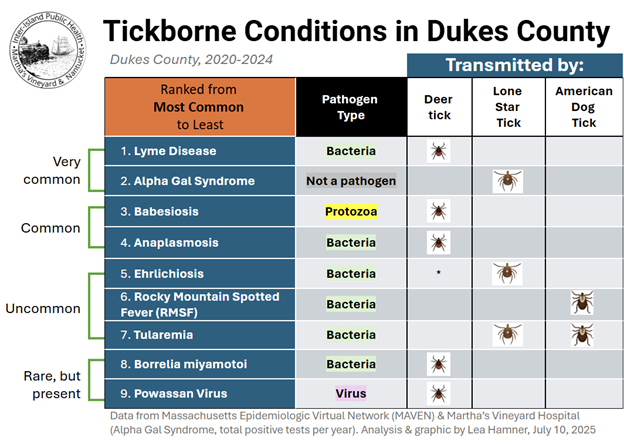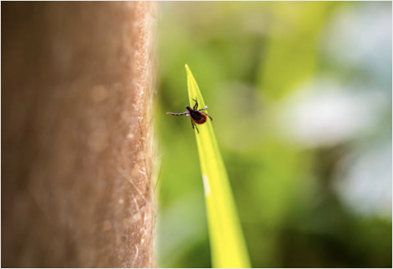Debunking Common Tick Myths
Ticks have become a fact of life on Martha’s Vineyard, but unfortunately, so has the misinformation about them. From unproven extermination remedies to unreliable control methods, myths about ticks and how to control them have been circulating in the community. Misunderstandings don’t just create confusion; they can lead to risky choices that may increase the likelihood of tick bites and tick-borne diseases. By separating fact from fiction, we can ensure that Vineyard residents and visitors have the accurate, science-based information they need to stay safe while outdoors.
Myth: You need an antibiotic after every tick bite.
Fact: Not all tick bites require antibiotics. Most tick bites do not lead to disease, and routine antibiotic treatment after any tick bite is not recommended. Contact your healthcare provider to help determine if antibiotics are appropriate based on your individual circumstances. Identifying the tick and estimating time it was attached is crucial for determining the necessary treatment and monitoring the relevant symptoms.
Because each situation is different, it’s essential to remove the tick promptly, keep the tick in a small bag or container, and monitor for symptoms such as rash, fever, or flu-like symptoms for up to 30 days after the bite. You can use TickSpotters, a free tick identification tool established by the University of Rhode Island, to gain information on your risk of disease based on the type of tick.
CDC: Lyme Disease Prophylaxis After Tick Bite
Myth: All ticks carry disease.
Fact: Not every tick carries a pathogen that can make you sick, and not every tick bite results in an illness. However, different species and life stages are more likely to transmit diseases. (Lea’s tickborne disease chart)
Although not all ticks can cause illness, it is impossible to determine by looking at one whether it carries a disease. That’s why prevention and identification are so important. Prompt tick checks, safe removal, and tick identification can help narrow down disease signs and symptoms to look out for and potential treatments. Lastly, protective measures such as permethrin-treated clothing and repellents can reduce the risk of disease transmission, regardless of the tick species you encounter. Testing services like TickReport.com are available to pathogen test ticks for a cost, view MA Department of Public Health’s page on tick testing services for more information.

Myth: We should introduce more opossums, guinea hens, turkeys, etc. to the Island to reduce the tick population.
Fact: While some animals may eat ticks, introducing or increasing populations of opossum or guinea hens is not an effective or reliable way to control tick populations. Tick ecology is complex, and the number of ticks in an area is influenced by numerous factors, including climate, habitat, and the abundance of tick hosts. Adding more opossums, guinea hens, or turkeys to Martha’s Vineyard will not make a meaningful dent in the overall tick population. In some cases, these animals can even host more ticks than they eat.
The most effective tick prevention strategies are those we can directly control: protecting ourselves with repellents and permethrin-treated clothing, performing regular tick checks, and keeping a tick kit in accessible locations. Relying on natural tick predators may sound appealing, but science indicates that personal protection remains the most effective defense.
Hennessy, C., & Hild, K. (2021). Are Virginia opossums really ecological traps for ticks? Groundtruthing laboratory observations. Ticks and Tick-Borne Diseases, 12, 101780. https://doi.org/10.1016/j.ttbdis.2021.101780
Means, R. G., & White, D. J. (1997). New distribution records of Amblyomma americanum (L.) (Acari: Ixodidae) in New York State. Journal of Vector Ecology: Journal of the Society for Vector Ecology, 22(2), 133–145.
White, A. L., Cumbie, A., Brinkerhoff, R. J., Hynes, W. L., & Gaff, H. D. (2024). Release the hens: A study on the complexities of guinea fowl as tick control. Journal of Medical Entomology, 61(2), 410–417. https://doi.org/10.1093/jme/tjad167
Myth: Ticks jump from trees.
Fact: Ticks do not jump, fly, or fall from trees. Instead, they wait close to the ground on grasses, shrubs, and leaf litter. They exhibit a behavior called “questing,” in which they outstretch their front legs to latch onto animals or people as they brush by. This is why tick bites are common on lower extremities, but keep in mind ticks will also crawl further up the host to bite around the head, ears, and scalp.
The idea that ticks drop from tree branches is a common misconception; however, understanding how they find hosts helps us focus prevention efforts where they are needed most. Tips: stay on clear paths, treat clothing with permethrin, apply repellents to exposed skin, and perform thorough tick checks.
Myth: Mice and other rodents are the leading cause of tick overpopulation.
Fact: Mice and other small rodents are essential in the tick life cycle, but they are not the primary driver of tick overpopulation. Blacklegged (deer) ticks feed on a variety of hosts at different life stages. Adult ticks rely heavily on deer to reproduce, making deer a key factor in sustaining local tick populations. Rodents, meanwhile, are significant reservoirs for disease-causing bacteria, such as those that cause Lyme disease, which are transmitted to ticks that feed on them.
Reducing the local deer population can significantly impact tick abundance, particularly on adult ticks, by limiting the number of available hosts for reproduction. On Martha’s Vineyard, deer populations are estimated to be 5-10 times higher than what is needed for a balanced ecosystem. The abundance of deer supports high numbers of adult ticks, which in turn contribute to the overall prevalence of ticks. IIPHEC is currently strategizing responsible ways to reduce deer numbers, such as controlled hunting, as part of a broader approach to lowering tick populations. While these strategies are being developed, personal protection and awareness of seasonal tick activity remain essential for preventing bites.
Rochlin, I., Kenney, J., Little, E., & Molaei, G. (2025). Public health significance of the white-tailed deer (Odocoileus virginianus) and its role in the eco-epidemiology of tick- and mosquito-borne diseases in North America. Parasites & Vectors, 18(1), 43. https://doi.org/10.1186/s13071-025-06674-6
Myth: Spraying the entire island with tick control treatments will help kill off the ticks.
Fact: Large-scale spraying is not a practical or effective solution for tick control, especially in an environment like Martha’s Vineyard. Unlike mosquitoes, which spend much of their life cycle in bodies of water that can be targeted and treated, ticks live in broader habitats that cover vast portions of the Island, making it impossible to spray any pesticide comprehensively without causing environmental and ecological harm. Non-toxic products do exist but need much further testing to demonstrate efficacy for tick control and its effects on non-target organisms.
Until broader interventions are developed, effective tick control relies on a more targeted, layered approach: managing deer populations, reducing tick habitats near homes, and using personal protection measures such as permethrin-treated clothing, repellents, and performing tick checks. These strategies offer the most sustainable way to reduce tick risks.
Myth: Ticks are only active during the warmer months.
Fact: While most human-biting tick species and life stages are active during the spring and summer months, adult deer ticks are most active from Fall into Spring. Adult deer ticks can even be active during Winter when temperatures are above 40°F. This means there is still potential for tick bites and the transmission of tick-borne diseases all year long.

Myth: If I don’t go in the woods, I won’t get ticks.
Fact: While wooded areas are high-risk for a tick encounter, it is not the only place where you can find them. Ticks thrive in leaf litter, brushy edges, tall grass, beach grass, and can even be found in landscaped yards. On Martha’s Vineyard, ticks are commonly found in backyards, gardens, and along walking paths or roads—not just in wooded areas.
Because ticks can be found in a variety of environments, avoiding the woods does not eliminate the risk. Regular yard maintenance, protective clothing, and consistent tick checks are essential steps, regardless of where you spend time outdoors.
Johnson, R. W., Roden-Reynolds, P., Snow, A. A., & Rich, S. M. (2024). The Spread of Lone Star Ticks (Amblyomma americanum) and Persistence of Blacklegged Ticks (Ixodes scapularis) on a Coastal Island in Massachusetts, USA. Insects, 15(9), Article 9. https://doi.org/10.3390/insects15090709
Ticks are a big nuisance on our Island, but the good news is that we’re not powerless against them. By understanding the facts and dispelling common myths, we can take simple, everyday steps to protect ourselves, our families, and our pets. Awareness and knowledge are the first lines of defense! Please visit our Tick-Borne Illness Page for more information and follow us on IIPHEC’s Facebook Page to keep up with the latest events and updates.




0 Comments